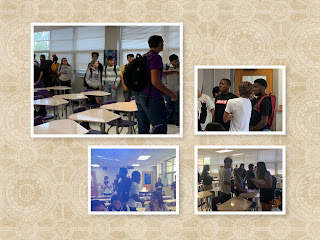It's All About Getting to Know Them
A lot of times the first week of school is focused on getting students settled into your rituals and routines. Several years ago while attending a National Board Certification training, I realized many of my classroom structures would be better followed if students helped me create them. I also realized it is hard to do a project if I don't kick off the year with one. As a result, the syllabus project was born and the first week of school changed. One of the changes is a focus on building community. Each day, students found their seat by completing a different challenge for the first 5 minutes of class. This allowed students to get to know each other but I also got to see various aspects of students. Here are the challenges for the five days:- Alphabetical order by last name without talking
- Shortest to tallest
- Least amount of siblings to most without talking
- Alternating heights without talking
- Birthday day (not year)
Entry Event
The project launch occurred over the first two days of the week. This launch is called an Entry Event. It is the first step of the project path described in PBLWorks' PBL 101 Workshops. After completing a notecard about themselves, students completed a chalk talk answering the question "What is the ultimate classroom?" This was my second time launching the project with this activity. Unlike last year, the students did not get into writing their dreams on the paper. Even after I prompted them that they could dream as big as they wanted, their was still little writing each hour (See the posters below). I should have changed the activity after two class periods did not show excitement, I choose to cut it short and move on to the second intake instead. My students showed later they really didn't believe me which caused them to not be all in.As a transition to the second part of the entry event, I reviewed some key classroom items like they experienced in other classes such as my course objectives, one rule and materials needed. I then worked to capture their emotions again by having them share problems they have encountered with other students and teachers. The class wrapped up with a close look at a a syllabus with missing parts to have one more heart capturing moment. They used a popular technique of notice and wonder to review the syllabus. Many wondered about the blank spots of the syllabus like I hoped. They then write their burning question about the project before the first day of the entry event ended.
The second day of the entry event was an assessment day and execution of a problem solving process I developed a few years ago. The assessment day was another way to show my class was not like others. It is not "gotchas", lacking proper preparation and void of proper support. We played grabbers and escape artists before taking a 3 question quiz. It was a way to review the essential components of the class while also reinforcing how my class is a place for them to create their community. They also used the syllabus which included some reminders of the answers to the test. We starting to work on the zoom sheet. This form is used to support the thinking process of making sense of a problem.
Making Sense of a Problem
The remainder of the week was working on the building their skill set of making sense of a problem and persevere in solving a problem which is mathematical practice from the common core as well as a skill identified by National Council of Teachers of Mathematics. They worked on following the process I modeled to find more items to fill into the three sections. The final section is my favorite because students not only create their own questions but also decide a method in which they will find the answer. I gave some class time during the 3rd and 4th day of the week for me to answer their questions since it was also their deadline day. The week ended with class meetings which always throws off the instructional day when you have classes with mixed grades. You basically lose an instructional day all together so I just allowed students another day to complete the three sections of the zoom sheet and those who were present to decide how we will work next week.My biggest regret
I have always loved an individual project work report created by PBLWorks' years ago. I tried to use it when I first was learned about it in 2008. It was an epic fail. I want to try and use it again this year. I have already incorporated it in the wrong way for this project. I should have introduced it when I was going to give them a long length of time to work on something without my guidance. I introduced it with too many new things. I am now three weeks into school and still trying to find a way to apologize for introducing it to my students to early and when it would be a better time to introduce it. Even when you have been doing projects for years (I started in 2005), you still make mistakes and things don't go like you thought.You can find the resources I used for this project at this link.


No comments:
Post a Comment